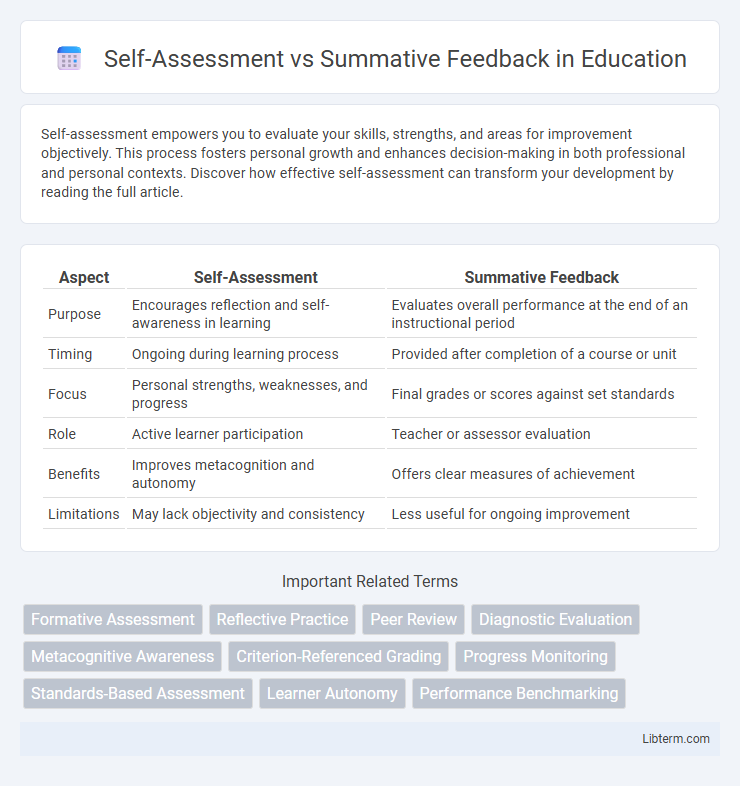Self-assessment empowers you to evaluate your skills, strengths, and areas for improvement objectively. This process fosters personal growth and enhances decision-making in both professional and personal contexts. Discover how effective self-assessment can transform your development by reading the full article.
Table of Comparison
| Aspect | Self-Assessment | Summative Feedback |
|---|---|---|
| Purpose | Encourages reflection and self-awareness in learning | Evaluates overall performance at the end of an instructional period |
| Timing | Ongoing during learning process | Provided after completion of a course or unit |
| Focus | Personal strengths, weaknesses, and progress | Final grades or scores against set standards |
| Role | Active learner participation | Teacher or assessor evaluation |
| Benefits | Improves metacognition and autonomy | Offers clear measures of achievement |
| Limitations | May lack objectivity and consistency | Less useful for ongoing improvement |
Understanding Self-Assessment: Definition and Importance
Self-assessment is the process where learners evaluate their own work, skills, and progress to identify strengths and areas for improvement. This reflective practice fosters metacognitive skills, encouraging deeper learning and personal accountability. Understanding self-assessment is crucial because it empowers individuals to take control of their learning journey, leading to enhanced motivation and better academic outcomes.
What is Summative Feedback? Key Characteristics
Summative feedback is an evaluative summary provided at the end of a learning period, designed to measure overall performance against predefined criteria or standards. It is characterized by its focus on final outcomes, often used for grading or certification purposes, and typically lacks detailed guidance for improvement. This type of feedback is formal, standardized, and aims to inform stakeholders about the learner's achievement level rather than the learning process.
Goals and Purposes: Self-Assessment vs Summative Feedback
Self-assessment empowers learners to identify personal strengths and areas for improvement, fostering metacognitive skills and autonomous goal-setting. Summative feedback evaluates overall performance against predetermined standards, providing a conclusive judgment often used for grading or certification. The purpose of self-assessment centers on continuous growth and self-regulation, while summative feedback aims to measure achievement and inform stakeholders of final outcomes.
Benefits of Self-Assessment in Learning and Development
Self-assessment enhances learners' metacognitive skills by fostering critical reflection on their own performance and understanding, leading to improved self-regulation and goal-setting. This process promotes active engagement and intrinsic motivation, empowering individuals to take ownership of their learning journey and identify areas for personal growth. Incorporating self-assessment in learning and development frameworks cultivates deeper comprehension, adaptability, and lifelong learning competencies essential for continuous professional advancement.
Advantages of Summative Feedback in Educational Settings
Summative feedback provides clear, objective evaluations of student performance, enabling educators to measure learning outcomes against established standards efficiently. It offers valuable benchmarks for academic achievement that guide curriculum adjustments and instructional improvements. This type of feedback also aids in accountability by delivering definitive performance data to stakeholders such as parents, administrators, and accreditation bodies.
Limitations and Challenges of Self-Assessment
Self-assessment often struggles with accuracy due to learners' biases and limited self-awareness, which can lead to either overestimation or underestimation of their abilities. It relies heavily on individual motivation and honesty, posing challenges in maintaining consistent and objective evaluation standards. Additionally, insufficient guidance or criteria can result in vague or unconstructive feedback, limiting its effectiveness in improving learning outcomes.
Drawbacks of Summative Feedback: Areas for Improvement
Summative feedback often lacks timely insights, limiting students' ability to address weaknesses during the learning process. It typically provides a final evaluation without detailed guidance on specific skills or knowledge gaps. This delayed and generalized feedback reduces opportunities for continuous improvement and personalized learning strategies.
Comparing Impact: Motivation and Engagement
Self-assessment fosters intrinsic motivation by encouraging learners to reflect on their own progress, deepening engagement through personal accountability. Summative feedback, while providing clear performance benchmarks, often influences motivation extrinsically by highlighting final outcomes rather than learning processes. Research shows that combining both approaches enhances overall learner motivation and sustained engagement by balancing self-regulation with external evaluation.
Practical Strategies for Balancing Both Approaches
Effective integration of self-assessment and summative feedback involves setting clear criteria and encouraging reflective practices that align with learning objectives. Utilizing rubrics and regular progress check-ins helps students critically evaluate their performance while teachers provide objective, summative insights. Combining these strategies fosters metacognitive skills and supports continuous improvement through balanced, actionable feedback.
Choosing the Right Assessment Method for Optimal Results
Choosing the right assessment method depends on the learning objectives and desired outcomes, where self-assessment fosters metacognitive skills by encouraging learners to reflect on their understanding and progress. Summative feedback provides a comprehensive evaluation of learner performance at the end of an instructional period, offering critical insights into mastery of content. Balancing self-assessment with summative feedback enhances both learner autonomy and objective measurement, leading to optimal educational results.
Self-Assessment Infographic

 libterm.com
libterm.com